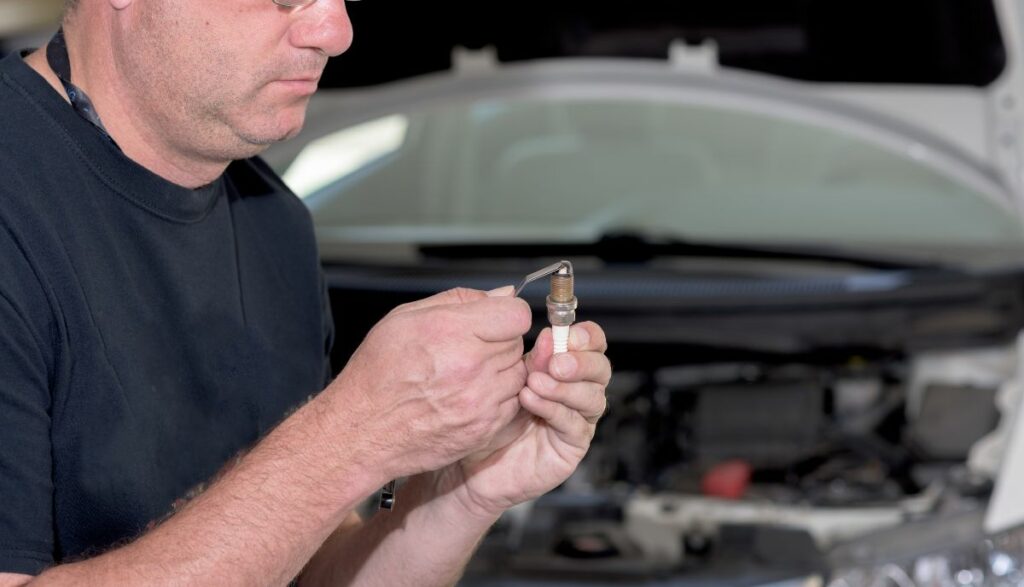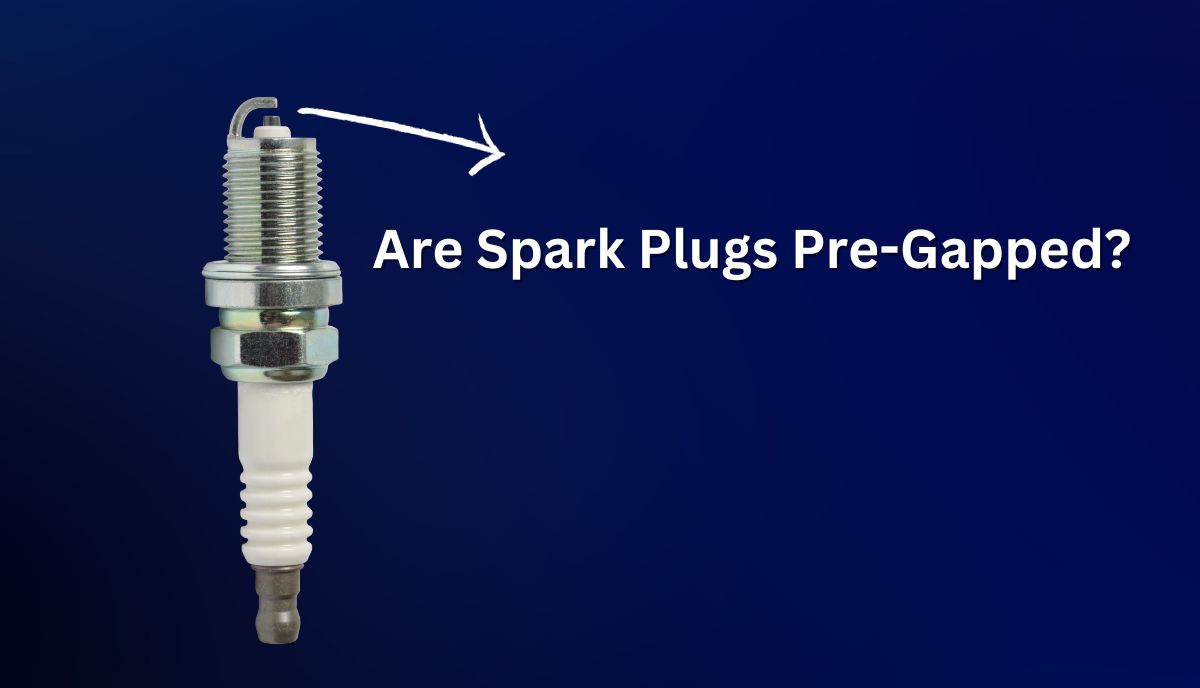Spark plugs are pre-gapped. Therefore, you can install them and run the vehicle immediately without making additional changes.
But is that true for everyone? Do manufacturers pre-gap their spark plugs?
| Brand | Pre-Gapped |
| NGK | Yes |
| Autolite | Yes |
| Motorcraft | Yes |
| Denso | Yes |
| Iridium | Yes |
| Bosch | Yes |
| AC Dleco | Yes |
| Champion | Yes |
This paper from Sang Leonard Tuei (KTH Industrial Engineering And Management) includes a picture of a spark plug showing the ground and central electrodes. It also notes that high operating temperatures and thermal loads eventually cause wear in the electrodes, which increases the gap between them.
But that doesn’t come as a surprise. Everyone expects the spark plug gap to change over time. Their biggest concern is the size of the gap in a new spark plug. Does it matter? Are adjustments necessary? The following will tell you everything you need to know:
What Does It Mean For Spark Plugs To Be Pre-Gapped?
A spark plug ignites the air/fuel mixture. It does this by sending a current across the gap between the electrodes. When mechanics mention the ‘Spark Plug Gap,’ their concern is the space between the electrodes at the top of the plug’s head.

Every spark plug has a gap. A space should always appear between those two electrodes. In that regard, every spark plug is pre-gapped. It comes with a preset space between the electrodes. A new spark plug without a gap is faulty.
Return it and get a refund or replacement. Without that space, a spark cannot arc between the electrodes to ignite the air/fuel mixture. That makes a spark plug without a gap useless.
Are Most Spark Plugs Pre-Gapped From The Factory?
Yes, most spark plugs are pre-gapped from the factory. However, keep in mind that spark plugs work in a variety of applications. You have new engine designs hitting the market every year. That doesn’t include the hundreds, possibly even thousands, that already exist.
This is a problem. According to NGK, the spark plug gap affects the temperature and voltage. Unfortunately, brands like NGK cannot make spark plugs with gaps that fit every automotive application. So, instead, their spark plug gaps will accommodate the most popular application.
That could mean dozens of engines or hundreds, depending on the field. Either way, you can’t always expect the gap a manufacturer sets in the factory to fit your engine’s needs. Keep this in mind when you buy spark plugs.
How Can You Tell If A Spark Plug Is Pre-Gapped?
A spark plug with a space between the electrodes has been pre-gapped. This applies to every spark plug coming out of most factories. A spark plug without a gap is faulty. Throw it away and get a replacement.
The gaps between the electrodes will vary with each manufacturer because different brands target different engines and applications. Most spark plug gaps fall within the 0.035 – 0.049-inch range. Many modern manufacturers mention the gap in the box.
This saves a lot of time. Without the gap measurements on the packaging, you must measure the space between the electrodes yourself and compare the readings to the manual’s recommendation.
Do Pre-Gapped Spark Plugs Need Further Adjustments?

Any mechanic you consult about this issue will mention one or more of the following:
- First, the need for gap adjustments is less prominent today than in previous decades.
- For a time, ignition systems came with drastically differing designs. This made gap adjustments a vital necessity.
- Fortunately, manufacturers used soft materials like copper, nickel-iron, and chromium to make the electrodes. You could adjust them with relative ease. Unfortunately, the gap would quickly open, leading to misfires.
- The fine-wire spark plugs of the 1990s changed everything because they relied on small tip electrodes made from precious metals like palladium and iridium that met the demands of increasing ignition system outputs while lasting significantly longer.
- Consider this 1979 paper from Kenneth J. Brumley (Old Dominion University), which notes that manufacturers expected consumers to buy new spark plugs every 10,000 miles. Compare that to spark plugs from today, which can easily last 100,000 miles.
- Today, many consumers disagree with gapping. They don’t think the practice matters in new engines. They are robust enough to tolerate minor differences in the space between the electrodes. As such, most pre-gapped plugs will work in most traditional applications, regardless of whether you make gapping alterations or not.
- Gapping can increase efficiency. You are fine-tuning the car’s functions as opposed to solving a significant problem.
- The wrong gap can only produce disastrous consequences if other things have gone wrong. But if the rest of the ignition system is okay, the vehicle can ignore erroneous gaps.
- Many drivers have never adjusted their spark plug gaps, yet their engines are okay.
What does this mean for you? You are better off measuring a new spark plug’s gap and determining whether it matches your car’s demands. This is the safer option. DJ Peanuts22 from the Red-Flag-Deals forum has also noted that it only takes five seconds to adjust a spark plug gap.
Therefore, where possible, alter the gap to optimize the vehicle’s performance. You don’t lose anything. That being said, spark plugs are brittle. You can do irreparable damage while adjusting the electrodes.
Therefore, laypeople should hire a professional to perform this task unless they trust their own abilities to adjust the spark plug without breaking it.
Why Is The Pre-Gap Important for Spark Plug Installation?
This paper from the IOP Conference Series (Materials Science And Engineering) provides an overview of a spark plug’s work in an engine. It blames a wide spark plug gap for deteriorating engine performance. Other notable concerns include:
- Misfires.
- Knocking.
- Poor gas mileage.
- Spark plug fouling.
The gap cannot be too wide or too small. Otherwise, the engine’s performance will suffer. Manufacturers use a pre-determined gap that accommodates the needs of the most popular applications on the market. However, the following can make adjustments in pre-gapped spark plugs necessary:
- Factory defects can occur. Some spark plugs have a gap that doesn’t match the dimensions stated on their packaging. This is why laypeople are encouraged to measure the gap even though they don’t intend to adjust it.
- Spark plugs can fall, causing the electrodes to shift.
- The mechanic can accidentally make the gap broader or narrower while inserting the spark plug. When you remove spark plugs from a faulty car and can’t see any carbon deposits or damage, the gap might be the problem. Measure it.
- The spark plug gaps may vary from brand to brand even though their spark plugs target the same applications. Therefore, you should measure the spark plug gap whenever you change brands.
- Have you modified your engine? A significant alteration can change the engine’s spark plug gap requirements. For instance, engines with high-compression pistons require a smaller gap. On the other hand, you should increase the gap for high-power ignition systems.
What Are The Consequences Of Using Non-Pre-Gapped Spark Plugs?
Yes, every spark plug comes with a gap. But that doesn’t mean every gap is correct for your application. Every pre-gapped spark plug can disrupt your vehicle’s operations, leading to misfires, poor gas mileage, loss of power, and other consequences unless you adjust the gap to match the information in the manual.
But as was mentioned earlier, the spark plug gap is not vital today. Modern vehicles can tolerate a variety of gaps. The exceptions are cars with modified engines. Manufacturers typically target the most popular applications. They cannot account for every engine’s spark plug gap requirements, let alone the modifications laypeople routinely perform.
This is why the safer option is to measure the gap of every new spark plug. Consult a mechanic if you notice discrepancies. The expert will determine whether or not the discrepancies matter.
Can You Adjust The Gap On Spark Plugs That Aren’t Pre-Gapped?

NGK prohibits consumers from adjusting fine wire spark plugs because the electrodes are fragile. They also expect fine wire plugs to outperform their standard counterparts regardless of whether or not you gap them.
The experts at Underhood Services argue that merely measuring the gap in fine-wire plugs is enough to damage the central electrode because it involves pushing a tool between the electrodes. Some manufacturers won’t explain why you can’t adjust their spark plugs.
But dismissing their instructions in this arena could void your warranty, especially if the engine sustains damage because you adjusted the plugs. This has never stopped laypeople from changing the spark plug gap in a process that involves the following:
- Clean the spark plug.
- Get a feeler gauge and measure the gap.
- Compare your readings to the recommended settings in the manual.
- If the readings diverge from the recommended settings, use a gap tool to increase or reduce the gap.
- Make slight adjustments using gentle motions. Otherwise, you may damage the spark plug.
- Keep adjusting and measuring until you create the recommended gap.
This Chris Fix video shows newbies how to measure and adjust a spark plug gap. Practice this process with an older plug you can afford to damage before experimenting with a new plug.

